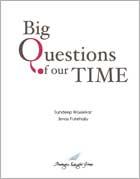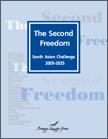Pakistan�€™s Parody
|
|
June, 2007
By Aheli Moitra & Sahiba Trivedi
|
Pakistan has currently been taking up a lot of media space in the international arena. The publicity triggered by General Pervez Musharraf�€™s sacking of the Chief Justice of Pakistan Iftikhar Mohammad Chaudhary escalated to the Karachi riots and the everlasting Jamia Hafza issue, creating a tight spot for Musharraf and is threatening to unseat him from his self-proclaimed political throne.
Musharraf�€™s filing of a reference of misconduct against Justice Chaudhary might have been the proverbial nail in the coffin of his autocratic reign of the past eight years. Little did he know that the happenings of March 9th would unleash such a reaction in Pakistan that his regime would threaten to buckle under pressure. However, this is not the first time where the Chief of Army Staff has suspended the Chief Justice and other judges in the country. A staggering majority of the masses stood against the reference, and included traders, students, farmers, retired army men, public transporters, doctors and teachers.
Could the reference have been a result of cases like the cancellation of the privatization of Pakistan Steel Mills, the forced disappearance cases and the ban on Basant festival that Justice Chaudhary had been involved in? The rumor mills are still active. The government had been growing uncomfortable over Justice Chaudhary�€™s bold handling of these cases. He seemed to be the only person from within the system who could stand up to Musharraf over these cases, and term his actions as illegal. It is therefore not inconceivable that Justice Chaudhary�€™s suspension was a simply ploy to get him out of the way.
However, Justice Chaudhary decided to get into a legal (and public) battle, challenging the reference against him in the Supreme Court as well as on the streets. He organized a number of rallies throughout the country in order to gain more public support. Justice Chaudhary�€™s rally in Karachi was scheduled for May 12th. Sindh�€™s ruling party, and Musharraf�€™s political ally, Muttahida Quami Movement (MQM) organized a pro-government rally in Karachi on the same day, in spite of the administration fearing clashes between Justice Chaudhary�€™s supporters and MQM members. The outcome was as expected- heavy riots and mass violence. The nation blamed MQM for the riots and the killings. As MQM is a political ally of the ruling Pakistan Muslim League (Quaid-e-Azam), MQM�€™s mistakes came to be identified as Musharraf�€™s mistakes in the end, thus gaining more public support for Justice Chaudhary. Since the government found itself pushed into a corner due to the severe criticism, it decided to use force to curb the nation�€™s voice.
Whenever anything against MQM was aired, or there was criticism against Musharraf�€™s government, the media outlets themselves started being attacked by para-military forces. Musharraf blamed the media for transmitting a negative image of the country and army and officially promulgated the PEMRA (Pakistan Electronic Media Regulatory Authority) Ordinance on June 6th to curb media freedom. He was forced to withdraw this ordinance on June 9th, under intense domestic and international pressure. However, no official notification for withdrawal has been issued till date.
For the past 3-4 months, speculations are rife that the US might �€˜force�€™ Musharraf to restore democracy in the country. The recent visit of US Assistant Secretary of State for South and Central Asian Affairs, Richard Boucher, and the upcoming visit of US Deputy Secretary of State, John Negroponte indicate that the US is in communication with Pakistan regarding the current political crisis and its resolution. On the flip side, General Musharraf, also, has to gratify his corps commanders so that he can maintain his position of ultimate power as Chief of Army Staff. Between appeasing the growing discontent in the West and his attempts to keep the army corps commanders happy, Musharraf seems to be walking a tight-rope which might result in his own dismissal from power.
In order to avoid his removal from power, General Musharraf might be forced to choose one out of the following three options in the coming months.
If General Musharraf steps down from both posts - President as well as Chief of Army Staff- it might mean a political vacuum for the nation and loss of an ally in the �€˜war against terror�€™ for the US. But that would be a simplistic reading. Musharraf has led the West to believe that without him at the helm of affairs in Pakistan, the country which is a nuclear state, could fall into the hands of Islamic fundamentalists and would lead to an Islamic revolution like that in Iran. He has used issues like the Lal Masjid and Jamia Hafza towards this end. The Lal Masjid and Jamia Hafza are mosques in Islamabad that are threatening to unleash jihadis�€™ at the state in case their demands, which include the implementation of Sharia in the state, are not met. The government has dealt with these in a very lax manner and as a result, the unrest over these issues has never completely died down. Luckily for the West, Musharraf out of the power structure in Pakistan does not equate to Islamic fundamentalists grabbing power. Rather, it means increased political confusion, with innumerable political factions battling for power. It could also involve the formation of a caretaker government in time for the next general elections. If this scenario plays out a possibility of Musharraf taking exile in a western country, most probably in the US is palpable.
The second scenario involves Musharraf retaining both his current positions. Since he has been pushed into a corner at the moment, the reinstatement of Chief Justice Iftikhar Chaudhary would appease the public and revive his dwindling public image. Removing the Chief Justice issue from the public eye effectively eliminates the controversy and silences the protests temporarily. To make sure he doesn�€™t face strong opposition in the General elections to be held sometime next year, he would not allow the exiled leaders Benazir Bhutto and Nawaz Sharief into the country to contest elections. In the Presidential elections scheduled to be held between September 15th and October 15th later this year, he would try to get himself re-elected as the President from the existing assemblies in uniform. In such a situation, with a lack of a �€˜leader�€™ of the masses, other political parties might try to bring out various issues in order to instigate the public against Musharraf. It would spark off mass-scale protests and could lead to violence on a level that Pakistan has not witnessed before, forcing the government to implement martial law.
The third option before Musharraf is that he steps down as the President of Pakistan and retains the post of the Chief of Army Staff. For this, he could go in for a power-sharing deal with Pakistan People�€™s Party Parliamentarians (PPPP) and other secular parties. With a new Prime Minister, a civilian President and Musharraf as the Chief of Army Staff, it would work to convince the world that democracy has been restored in Pakistan. Considering the position of power that the army has always held in the country, Musharraf would continue to be in power, while avoiding the controversy of holding dual offices, re-election from present assemblies and conducting of free and fair polls. The added advantage to such a deal would be the removal of international pressure on Pakistan.
Considering the present situation in Pakistan, it is probable that in the coming months, General Musharraf might choose the third option. While this would mean a change of faces in the government, the real power in Pakistan was and would continue to remain with the army. It would successfully �€˜restore democracy�€™ to the nation and make sure that General Musharraf is still in command of the army to see US�€™s �€˜war on terror�€™ to its end. Whether it is Benazir Bhutto or Nawaz Sharief, who becomes the next Prime Minister of Pakistan, General Musharraf would guarantee his survival in the power structure of Pakistan.
Related Publications
-
.jpg&maxw=50)
Big Questions of Our time: The World Speaks, 2016
Download:Big Questions of Our time: The World Speaks _Full Report
-

-

Second Freedom South Asian Challenge 2005-2025, 2005
read more
Download:Second Freedom South Asian Challenge 2005-2025 Full Report
Related latest News
Related Conferences Reports
-

Global Challenges Conference, October 2016
Download:Global Challenges Conference Report
-

Conference on Responsibility to the Future: Business, Peace and Sustainability, June, 2008
Download:Global Security and Economy: Emerging Issues


